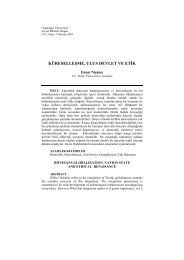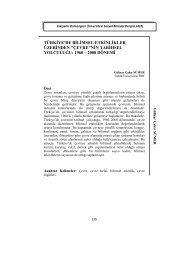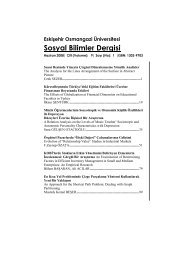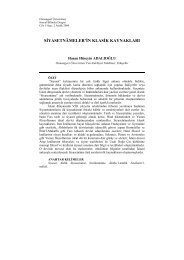image of muslim turks on the restoration stage - Eskişehir ...
image of muslim turks on the restoration stage - Eskişehir ...
image of muslim turks on the restoration stage - Eskişehir ...
Create successful ePaper yourself
Turn your PDF publications into a flip-book with our unique Google optimized e-Paper software.
B. Ayça ÜLKER ERKAN<br />
<strong>Eskişehir</strong> Osmangazi Üniversitesi Sosyal Bilimler Dergisi, 11(2)<br />
<strong>the</strong> first woman called Pandora as being sent by <strong>the</strong> angry God, Zeus, to<br />
be <strong>the</strong> cause <str<strong>on</strong>g>of</str<strong>on</strong>g> men’s misery (Murphy 2). The very same idea recurs in<br />
<strong>the</strong> biblical story pointing out that humanity was thrown away from Eden<br />
because <str<strong>on</strong>g>of</str<strong>on</strong>g> Eve’s eating <strong>the</strong> forbidden apple. In this perspective, women,<br />
female desire, and sexuality were c<strong>on</strong>sidered as threat to <strong>the</strong> power <str<strong>on</strong>g>of</str<strong>on</strong>g><br />
patriarchy. This idea appears in <strong>the</strong> quotati<strong>on</strong> above. Ismael’s speech<br />
drew attenti<strong>on</strong> to <strong>the</strong> power <str<strong>on</strong>g>of</str<strong>on</strong>g> female desire and fear <str<strong>on</strong>g>of</str<strong>on</strong>g> female sexuality.<br />
3.3. Farquhar’s The Beaux’ Stratagem<br />
The establishment <str<strong>on</strong>g>of</str<strong>on</strong>g> <strong>the</strong> Western fear <str<strong>on</strong>g>of</str<strong>on</strong>g> <strong>the</strong> expansi<strong>on</strong>ist Ottomans and<br />
<strong>the</strong>ir c<strong>on</strong>sequent curiosity and interest created ano<strong>the</strong>r “devastating” and<br />
“sensuous” figure in George Farquhar’s The Beaux’ Stratagem (1707).<br />
This Restorati<strong>on</strong> play c<strong>on</strong>sisted <str<strong>on</strong>g>of</str<strong>on</strong>g> <strong>the</strong> least Turkish settings or character<br />
because Farquhar slightly menti<strong>on</strong>ed <strong>the</strong> Turkish <strong>the</strong>me appearing as a<br />
negative <str<strong>on</strong>g>image</str<strong>on</strong>g>. Said (1979) emphasized <strong>the</strong> attitude <str<strong>on</strong>g>of</str<strong>on</strong>g> <strong>the</strong> Europeans<br />
towards Islamic expansi<strong>on</strong> as follows:<br />
Yet where Islam was c<strong>on</strong>cerned, European fear, if not<br />
always respect, was in order . . . .<br />
Not for nothing did Islam come to symbolize terror,<br />
devastati<strong>on</strong>, <strong>the</strong> dem<strong>on</strong>ic, hordes <str<strong>on</strong>g>of</str<strong>on</strong>g> hated barbarians. For<br />
Europe, Islam was a lasting trauma. Until <strong>the</strong> end <str<strong>on</strong>g>of</str<strong>on</strong>g> <strong>the</strong><br />
seventeenth century <strong>the</strong> ‘Ottoman peril’ lurked al<strong>on</strong>gside<br />
Europe to represent for <strong>the</strong> whole <str<strong>on</strong>g>of</str<strong>on</strong>g> Christian civilizati<strong>on</strong><br />
a c<strong>on</strong>stant danger . . . (59).<br />
Not much Muslim Turks were found in The Beaux’ Strategem if<br />
compared to <strong>the</strong> o<strong>the</strong>r c<strong>on</strong>temporary Restorati<strong>on</strong> dramas in which <strong>the</strong><br />
Ottoman Empire appeared <strong>on</strong> <strong>the</strong> British <strong>stage</strong>. Farquhar, like all o<strong>the</strong>r<br />
dramatists <str<strong>on</strong>g>of</str<strong>on</strong>g> <strong>the</strong> era, was affected by <strong>the</strong> Ottoman Empire and <strong>the</strong><br />
Turkish people. Still, <strong>the</strong> <str<strong>on</strong>g>image</str<strong>on</strong>g> <str<strong>on</strong>g>of</str<strong>on</strong>g> Muslim Turks appeared ideologically<br />
in <strong>the</strong> play, although <strong>the</strong> play was nei<strong>the</strong>r about Muslim Turks nor a<br />
Turkish setting.<br />
The plot <str<strong>on</strong>g>of</str<strong>on</strong>g> The Beaux’ Strategem revolved around decepti<strong>on</strong> and <strong>the</strong><br />
purpose <str<strong>on</strong>g>of</str<strong>on</strong>g> <strong>the</strong> main characters was finding a wealthy wife. N<strong>on</strong>e <str<strong>on</strong>g>of</str<strong>on</strong>g> <strong>the</strong><br />
characters in <strong>the</strong> play was h<strong>on</strong>est. In <strong>the</strong> first act, Farquhar introduced <strong>the</strong><br />
motives and plan <str<strong>on</strong>g>of</str<strong>on</strong>g> Archer and Aimwell, two fortune hunting and flirting<br />
young men. In <strong>the</strong> sec<strong>on</strong>d act, <strong>the</strong> playwright pointed out how Mrs.<br />
Sullen’s marriage was insufferable. Actually, she had a stratagem in<br />
which she flirted with Count Bellair to take revenge <strong>on</strong> her husband. In<br />
<strong>the</strong> developing act, we learn that B<strong>on</strong>niface (<strong>the</strong> innkeeper) and his<br />
highwaymen were frauds planning to rob Lady Bountiful. In <strong>the</strong> third act,<br />
36









